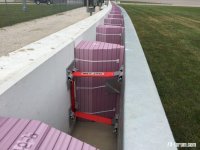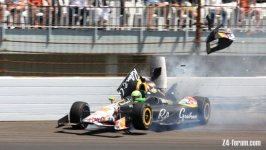>
You are using an out of date browser. It may not display this or other websites correctly.
You should upgrade or use an alternative browser.
You should upgrade or use an alternative browser.
How lucky was Grosjean!
- Thread starter obewan
- Start date
Very lucky lad and goes to prove that the drivers insisting on safety is a good thing
jabber said:When I saw it live I must admit I definitely feared the worst. It is amazing he survived and was able to get out with relatively minor injuries
Same here, especially when the TV pictures never went back to it for a few minutes.
I assume they were waiting to make sure he was OK
Amazed he managed to get out on his own.
The Hass team are saying the impact was recorded at 53G
Shocking. Feared the worse. Amazing to see him walk away.
Just watched it on CH4. I spotted this thread title earlier in the day, but didn't read the thread. For a second I though s#it hope he's ok. Then in the next second I recalled the thread title here.
Every thing did it's job and luck or amazing engineering helping to create it's own luck. Apart from the crash barrier, it gets a from me.
from me.
Every thing did it's job and luck or amazing engineering helping to create it's own luck. Apart from the crash barrier, it gets a

 The Halo and his helmet/overalls definitely saved Grosjean there but that Armco barrier should not have failed like that. Absolutely no Recticel/SAFER barrier in use that I can see anywhere on the Bahrain circuit. The Americans have been using strategically place Recticel/SAFER for quite some time now with great success. It absorbs huge amounts of energy and deflects the car rather than stopping the car dead in its tracks. Surely the FIA/F1 need to reassess its use ?
The Halo and his helmet/overalls definitely saved Grosjean there but that Armco barrier should not have failed like that. Absolutely no Recticel/SAFER barrier in use that I can see anywhere on the Bahrain circuit. The Americans have been using strategically place Recticel/SAFER for quite some time now with great success. It absorbs huge amounts of energy and deflects the car rather than stopping the car dead in its tracks. Surely the FIA/F1 need to reassess its use ?Back in the turbo car days the drivers used to have emergency oxygen fed into their helmets in the event of an accident - does that not happen any more? Twenty seconds worth i seem to remember?
patriot66 said:1449261063-TRACK-5.jpg635627333318409368-AP-IndyCar-Indy-500-Auto-Racing.jpgThe Halo and his helmet/overalls definitely saved Grosjean there but that Armco barrier should not have failed like that. Absolutely no Recticel/SAFER barrier in use that I can see anywhere on the Bahrain circuit. The Americans have been using strategically place Recticel/SAFER for quite some time now with great success. It absorbs huge amounts of energy and deflects the car rather than stopping the car dead in its tracks. Surely the FIA/F1 need to reassess its use ?
Not seen those barriers up close before, looks superb, pretty much a floating barrier, awesome idea.
patriot66 said:1449261063-TRACK-5.jpg635627333318409368-AP-IndyCar-Indy-500-Auto-Racing.jpgThe Halo and his helmet/overalls definitely saved Grosjean there but that Armco barrier should not have failed like that. Absolutely no Recticel/SAFER barrier in use that I can see anywhere on the Bahrain circuit. The Americans have been using strategically place Recticel/SAFER for quite some time now with great success. It absorbs huge amounts of energy and deflects the car rather than stopping the car dead in its tracks. Surely the FIA/F1 need to reassess its use ?
Absolutely agree. Where luck definitely came in was that the safety cell made it through to the other side. Otherwise he could so easily have been trapped under the Armco. No doubt the computers will be running G force calculations on what could have been for that crash with other barriers.
Just so glad he got out so quickly.
These type of barriers are not meant to be solid, they are meant to absorb the impact in many ways...from deflection (of car or barrier), deformation (of barrier), breakage (of barrier, bolts and supports). Each component requires a certain level of force to fail, and the safety certificate for the track will tell you where you need what (at a minimum) for maybe the 1 in 1000 case (which this was).
The barrier only 'failed' that way because they weren't designed with the HALO device in mind, or to be prised apart that much before popping off the bolts holding them in place.
If the cars had no HALO device, then it probably wouldn't have 'failed' so much, but then the outcome would have been much worse.
Looking at the aerial shots during the red flag, it did seem to me that the barriers came out at a sharper angle, wrong layout than I'd expect.

I'm not sure whether Grosjean would have preferred crashing into the armco barriers, or the concrete blocks that were put in their place afterwards. Maybe the concrete blocks would not absorb the impact as much and that 53G impact might have been a 153G impact?
With the money F1 have (and some of these circuits/states), there should be no excuse not to have the 'best' protection around every part of the track - but what's 'best' for one situation/type of crash, is not always the best for another.
The barrier only 'failed' that way because they weren't designed with the HALO device in mind, or to be prised apart that much before popping off the bolts holding them in place.
If the cars had no HALO device, then it probably wouldn't have 'failed' so much, but then the outcome would have been much worse.
Looking at the aerial shots during the red flag, it did seem to me that the barriers came out at a sharper angle, wrong layout than I'd expect.

I'm not sure whether Grosjean would have preferred crashing into the armco barriers, or the concrete blocks that were put in their place afterwards. Maybe the concrete blocks would not absorb the impact as much and that 53G impact might have been a 153G impact?
With the money F1 have (and some of these circuits/states), there should be no excuse not to have the 'best' protection around every part of the track - but what's 'best' for one situation/type of crash, is not always the best for another.
Part of the problem is that the crash happened in a very strange place - essentially a third of the way down a long straight. all the run off and tecpro barriers are at the corners and braking zones.
Similar situation at tracks around the world, minimal run off and barriers along straights. Imagine if this type of incident had happened along the wellington straight at silverstone, just at the point where the track narrows to go underneath the bridge...
while im very glad that Grosjean walked away from a very scary crash, swerving around like he did on the straight is asking for trouble - hence why drivers moving in the braking zones has had such attention in recent years.
Similar situation at tracks around the world, minimal run off and barriers along straights. Imagine if this type of incident had happened along the wellington straight at silverstone, just at the point where the track narrows to go underneath the bridge...
while im very glad that Grosjean walked away from a very scary crash, swerving around like he did on the straight is asking for trouble - hence why drivers moving in the braking zones has had such attention in recent years.
brillomaster said:Part of the problem is that the crash happened in a very strange place - essentially a third of the way down a long straight. all the run off and tecpro barriers are at the corners and braking zones.
Similar situation at tracks around the world, minimal run off and barriers along straights. Imagine if this type of incident had happened along the wellington straight at silverstone, just at the point where the track narrows to go underneath the bridge...
while im very glad that Grosjean walked away from a very scary crash, swerving around like he did on the straight is asking for trouble - hence why drivers moving in the braking zones has had such attention in recent years.
Wasn’t he being squeezed on his left and taking avoiding action...?
Smartbear said:Looks like he swerved across & chopped off the other guys nose?
Rob
thats how i read it... either go left (and off the track) to avoid some slow cars ahead, or go right. there was almost a gap too. some might argue that a better driver would have known what cars were around him and avoided the incident.